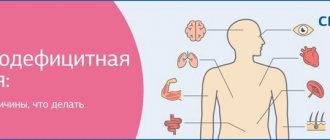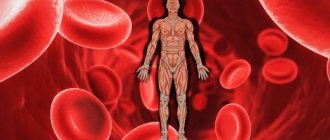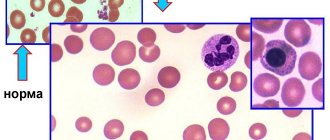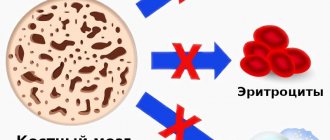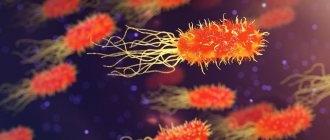Detailed description of the study
Anemias are conditions that occur when the number of red blood cells - red blood cells - and the concentration of hemoglobin in a person's blood are significantly reduced.
Hemoglobin is a complex iron-containing protein found in red blood cells and is essential for transporting oxygen from the lungs to the tissues.
The main causes of anemia include:
- Impaired or decreased production of red blood cells, which may be associated with deficiency of iron or B vitamins, the presence of certain cancers, inhibition of the hematopoietic function of the bone marrow;
- Significant loss of red blood cells after massive bleeding (posthemorrhagic anemia);
- Increased breakdown (hemolysis) of red blood cells (hemolytic anemia).
Anemia can be acute or chronic. Chronic anemia, as a rule, accompanies other diseases (diabetes mellitus, cancer, chronic renal failure) and in most cases is asymptomatic or with minimal clinical manifestations.
The main clinical symptoms of anemia:
- Increased fatigue;
- Dyspnea;
- Dizziness;
- Tachycardia - rapid heartbeat;
- Pale skin.
Anemia is a fairly common condition diagnosed in both men and women. However, some factors increase the risk of developing pathology:
- Diet low in iron source foods (vegetarianism);
- Acute and chronic kidney diseases;
- Some autoimmune diseases (diabetes mellitus);
- Oncological diseases;
- Inflammatory bowel diseases;
- Genetic predisposition;
- Chronic infectious diseases (tuberculosis);
- Conditions after injuries and surgical interventions;
- Chronic bleeding.
To diagnose anemia, a number of laboratory parameters are determined. This comprehensive laboratory test includes all the necessary tests to diagnose anemia and determine the causes of its development.
General blood test extended with leukocyte formula and reticulocytes.
The analysis allows you to determine the concentration of hemoglobin, estimate the number of blood cells, as well as a number of other important indicators (color index, normoblasts).
This test evaluates three types of blood cells:
- Red blood cells (erythrocytes and reticulocytes) Erythrocytes are the most numerous group of all the formed elements of blood. They contain iron-containing protein - hemoglobin and together with it transport oxygen throughout the body. A decrease in hemoglobin concentration is the main indicator of anemia. Reticulocytes are immature red blood cells. The number of reticulocytes reflects their production by the bone marrow. The study of this parameter allows us to assess the hematopoietic function of the bone marrow.
- White blood cells (leukocytes) Leukocytes are cells that are constantly present in the blood, lymphatic system and tissues, and are an important part of the body's natural defense (immune) system. They provide protection against infections and also participate in the formation of inflammation and allergies. The number of leukocytes in the blood is relatively stable. A change in the number of leukocytes occurs in response to a change in the state of the body (infectious disease, inflammation, etc.).
- Platelets Platelets are blood cells that circulate in the blood and are necessary for its normal clotting. When a vessel wall is damaged, platelets help stop bleeding by adhering to the site of injury and forming a temporary plug. Diseases or conditions that are associated with low platelet levels (thrombocytopenia) or decreased platelet function increase the risk of developing anemia.
Also, with anemia, normoblasts, the precursors of reticulocytes, can be found in the blood. Normally, these cells can only be found in the bone marrow; their appearance in the bloodstream is a sign of pathology.
- ESR according to Westergren (venous blood) Erythrocyte sedimentation rate (ESR) is an indicator that depends on the ratio of protein fractions in the blood and the number of red blood cells. A change in ESR may indicate the presence of an inflammatory, autoimmune or oncological disease, which may cause the development of anemia. An increase in ESR is normally observed in any acute or chronic inflammatory process.
- Transferrin, ferritin and THC These indicators reflect the metabolism of iron in the body. This trace element is mainly included in the hemoglobin of red blood cells and is necessary for their normal production by the bone marrow. A person gets iron from foods (liver, red meat, spinach, legumes). When iron is absorbed in the intestine, it is transported by transferrin. Determining the level of transferrin reflects the total “reserves” of iron in the body. TIBC (total iron-binding capacity of serum) is an indicator that reflects the amount of iron that can be bound by transferrin. In healthy people, part of the iron entering the body is contained in hemoglobin. The other part is stored in tissues in combination with ferritin or hemosiderin. Ferritin is a protein complex that acts as the main “storage” of iron in the body. A small portion of ferritin is present in the blood; by measuring this indicator, iron reserves can also be assessed. These studies allow us to indirectly assess the amount of iron in the body in order to diagnose its deficiency and determine the cause of anemia.
- Folates and vitamin B12 Vitamin B12 and folic acid (vitamin B9) are representatives of the B vitamins, which are necessary for the body to produce red blood cells, white blood cells, and the synthesis of nucleic acids. Vitamin B12 also ensures the functional activity of cells in the central nervous system. Folates are salts of folic acid, a natural form of vitamin B9.
Vitamin B12 and/or folic acid deficiency reflects a chronic lack of one or both of these vitamins. Long-term deficiency of vitamin B12 or folic acid can lead to macrocytic anemia. In this case, the production of red blood cells by the bone marrow decreases, while they increase in size, and their ability to transport oxygen is significantly reduced, which causes hypoxia (oxygen deficiency in tissues).
Characteristic clinical signs of B12 deficiency anemia include:
- Constantly increasing weakness, apathy;
- Rapid heartbeat, heart pain;
- Weakness in the legs, “numbness” of the limbs;
- Swelling and pale complexion.
The most common cause of vitamin B12 deficiency is impaired absorption in the intestine. This may be due to chronic inflammatory diseases of the intestinal mucosa (atrophic gastritis), surgical removal of part of the organ, or some hereditary absorption pathologies.
Most anemia is a complication of other diseases, so in order to choose the right treatment tactics, it is necessary to find out the cause of the anemia. The studies included in this complex make it possible to assess the qualitative and quantitative composition of cells and biochemical parameters of the blood system, as well as to identify disturbances in its functioning. Based on the test results, it is possible to carry out a primary diagnosis of anemia, as well as a differential diagnosis of the types of disease.
A detailed description of the studies and reference values are presented on the pages with descriptions of individual studies.
In what cases is a study prescribed?
The reason for prescribing the analysis is diagnosed bone marrow diseases, as well as general symptoms of anemia:
- pallor of the skin and mucous membranes (conjunctiva, gums, tongue);
- unjustified weakness;
- fast fatiguability;
- rapid pulse (lack of oxygen causes the heart to pump blood harder).
During a general examination, you should pay attention to specific symptoms characteristic of a particular type of anemia:
- brittle hair and nails (iron deficiency anemia);
- bright crimson tongue (B12 deficiency anemia);
- yellowness of the skin and eye sclera (hemolytic anemia)
A routine analysis of hemoglobin levels is carried out for a comprehensive assessment of the condition during pregnancy, before bone marrow transplants or interventions affecting the hematopoietic organs. Periodic monitoring requires hormonal therapy (primarily with erythropoietin preparations), as well as long-term use of iron-containing drugs.
Classification of anemia
The diagnosis specifies not only the cause of the pathology, but also specifies the severity of the anemia.
This parameter depends on the level of hemoglobin in the blood (Table 1). Table 1. Severity of anemia by hemoglobin level.
| Age, gender of the patient | Mild degree | Average degree | Severe degree |
| From 6 months to 4 years | 109–100 g/l | 70–99 g/l | 69 g/l and below |
| From 5 to 11 years | 114–110 g/l | 109–80 g/l | 79 g/l and below |
| From 12 to 14 years | 119–110 g/l | 109–80 g/l | 79 g/l and below |
| Women 15 years and older | 119–110 g/l | 109–80 g/l | 79 g/l and below |
| Men 15 years and older | 123–110 g/l | 109–80 g/l | 79 g/l and below |
| Pregnant women | 109–100 g/l | 70–99 g/l | 69 g/l and below |
In the blood of patients with suspected anemia, not only the hemoglobin level is determined, but also a number of other indicators:
- the presence of specific “young” forms of red blood cells;
- size and shape of red blood cells;
- color indicator - the relative amount of hemoglobin in one red blood cell;
- hematocrit - “blood density”, the ratio of its liquid part and formed elements.
For each of these parameters, there are separate classifications of anemia. Their use in clinical practice facilitates differential diagnosis, allows one to assess the severity of the course, the effectiveness of treatment and determine the patient’s prognosis.
How to eat properly if you have anemia
For any type of anemia, treatment is based not only on the use of medications. Great importance in therapy is given to the organization of therapeutic nutrition, its main goal is to saturate the body with substances that are necessary for the process of hematopoiesis.
It is especially important to reconsider the dietary habits of patients with deficiency anemia - by changing the diet, the level of iron (Fig. 5), folic acid and vitamin B12 can be restored.
Figure 5. Foods high in iron. Source: yuliyafurman / freepik.com
According to recommendations, people with anemia should eat 4-5 times a day. At the same time, the energy value of the diet must be sufficient - a calorie deficit must be abandoned.
Important! Proper nutrition for anemia is an important component of complex therapy. But it is impossible to compensate for iron deficiency through diet alone. No more than 2.5 mg of iron is absorbed per day from food, and about 12.5-50 mg from medications.
It is important to include dishes from red meat, fish, poultry, and meat products in the menu of patients with anemia. Animal proteins contain large amounts of essential amino acids. They are important for normal hemoglobin synthesis, formation and maturation of red blood cells. Meat also contains iron in a specific form, which is best absorbed by the human body. You can also use eggs and dairy products - cottage cheese, yoghurts, cheeses - as a source of protein and vitamin B12 (Fig. 6).
Figure 6. Foods high in vitamin B12. Source: sonulkaster / freepik.com
If you have IDA, it is better to avoid dairy products—the calcium in them interferes with the absorption of iron. It is also better to refrain from coffee and strong tea - caffeine impairs the absorption of the microelement.
Excess fat disrupts metabolic processes and generally negatively affects the body. Therefore, people with anemia are advised not to eat fatty meats, fried foods, and trans fats. As the main sources of “good” cholesterol, it is better to include fatty fish and vegetable oils, such as olive, in your diet.
Carbohydrates do not have a serious effect on the formation of red blood cells, but their excess increases the risk of various chronic diseases. Therefore, it is better to give up sweets and desserts, and add fruits, cereals, wholemeal bread, and honey to the menu as a source of carbohydrates.
Essential components for hematopoiesis are vitamins B, C, and PP. They are found in large quantities in fresh berries, fruits and vegetables.
Soups made with meat broth are useful for people with anemia. They help increase the secretion of gastric juice, thereby improving the absorption of iron and vitamin B12.
Other minerals are also needed for hemoglobin synthesis:
- manganese;
- zinc;
- cobalt;
- copper.
These trace elements are found in beef, cereals, porcini mushrooms, eggs, legumes, and cocoa.
Meat dishes are best combined with a side dish of potatoes, tomatoes, bell peppers, broccoli, and sauerkraut. These vegetables are rich in ascorbic acid, which improves the absorption of iron from the digestive tract.
For anemia, mineral waters with additional iron content are useful. It is better to replace sweet carbonated drinks, coffee and tea with dried fruit compote, rose hip decoction, fresh juices, cranberry or lingonberry juice.
Vegetarianism and anemia
Experts say that IDA is as common in vegetarians as in non-vegetarians.
Although their iron levels tend to be lower, ferritin is usually normal.8 To avoid developing anemia, people on a plant-based diet should meet the recommended iron intake, which averages 18 mg/day. It is necessary to take into account the fact that iron from plant food sources is absorbed less well (5-10%) than from animal products (18%). Thus, the iron requirement for vegetarians is approximately 1.8 times higher.
Some foods that can help vegetarians and vegans get the iron they need include:
- soya beans;
- lentils;
- spinach;
- tofu;
- broccoli.
It is also important to eat foods rich in vitamin C, which facilitate the absorption of non-heme iron.
Sources
- Rakisheva A.G., Berkinbaev S.F., Musagalieva A.T., Kubeeva A.Sh., Khan O.R. Prevalence of anemia and iron deficiency in the city of Almaty and Almaty region // Medicine (Almaty). – 2021. – No. 5 (179). – P. 62-65
- Anemia. Wikipedia (wikipedia.org)
- Hemolytic anemia: textbook / T.I. Pushkareva, E.B. Romantsova. – Blagoveshchensk: Bukvitsa, 2010. – 33 p.
- Lecture 2. Anemia: classification, general characteristics of hematological changes. Posthemorrhagic anemia. International Journal of Applied and Basic Research. – 2015. – No. 6 (part 1) – P. 152-155
- Mikhailova E.A., Fidarova Z.T., Troitskaya V.V., Klyasova G.A., Kulagin A.D., Voronova E.V., Dvirnyk V.N., Galtseva I.V., Kovrigina A. M., Obukhova T.N., Gaponova T.V., Parovichnikova E.N., Savchenko V.G. Clinical guidelines for the diagnosis and treatment of aplastic anemia (2021 edition). Hematology and transfusiology. 2020;65(2):208-226.
- Anemia. Mayo Clinic.
- Strutynsky A.V. Iron deficiency anemia in the practice of a general practitioner: diagnosis and treatment. Pharmateka. - 2012. - No. 13.
- Position of the American Dietetic Association and Dietitians of Canada: Vegetarian Diets J Am Diet Assoc. -2003. -No. 103 (6). -R. 748-765.
Modern methods for diagnosing anemia
To diagnose anemia, laboratory and instrumental research methods are used. For proper treatment, it is important to determine not only the fact of anemia and its type, but also the cause of this condition. It is better to detect the disease in the early stages of the process and do this using a variety of diagnostic methods. A complete picture of the state of the body gives a more complete understanding of the pathology. Only after a quality examination can effective treatment be prescribed.
The main method for diagnosing anemia is a complete blood count. with its help you can determine the number of red blood cells and hemoglobin, their ratio, color index, hematocrit, red blood cell diameter and other indicators. Sometimes, other indicators of a general blood test - the levels of other blood cells, ESR - can tell about the cause of the pathology. This test is performed first if anemia is suspected. Depending on its results, other diagnostic methods are prescribed.
A biochemical blood test will determine the level of serum iron, proteins that carry it, and the amount of vitamins B12 and B9. It is the biochemical analysis that helps to calculate the level of bilirubin and its fractions. thus, this manipulation is required to clarify the type of anemia. The analysis allows you to evaluate most processes in the body and provides comprehensive information about the functioning of internal organs.
The study of free protoporphyrin in erythrocytes determines the ability of erythrocytes to carry oxygen and allows us to determine the causes of anemia. Impaired heme binding is observed during acute intoxication and can be detected using this technique.
Bone marrow puncture analysis shows the presence of blasts, the precursors of blood cells. Diagnostics are used to confirm or rule out aplastic anemia. In addition, the levels of other missing cells need to be corrected. The study is combined with other diagnostic methods. Early initiation of treatment improves the prognosis for the patient and is only possible after a quality diagnosis.
A study of the acidity of gastric juice (pH-metry) is necessary to diagnose iron deficiency anemia. It is necessary to determine why the absorption of iron in the intestine is impaired and for this purpose this diagnosis is carried out. Increased production of gastric juice negatively affects other functions of the body, leads to chronic changes in the mucous membrane and causes secondary disorders.
The presence of parasites in the body leads to increased consumption of most useful substances and can provoke the occurrence of anemia. Their searches are also included in the anemia diagnostic program. It is worms that can provoke the development of megaloblastic, iron deficiency anemia. In addition, parasitic infection negatively affects other organs and systems, leading to chronic impairment of many functions.
Examination of stool for occult blood allows one to determine blood loss, due to which posthemorrhagic anemia occurs. Also, blood loss is a sign of gastrointestinal pathology that needs to be detected and treated. If you delay in finding the cause of anemia, the disease can progress, and the later the stage of the process, the more difficult it is to treat.
X-ray and endoscopic examination are necessary to detect the source of bleeding that led to anemia. This examination allows you to find pathology that needs to be corrected not only to treat anemia, but also for the full health of the body.
Risk factors for anemia
To determine the likelihood of developing anemia, you should know the risk factors for the pathology. These include:
- age over 65 years;
- female - regular menstruation increases the likelihood of red blood cell loss;
- following a diet deficient in certain vitamins or minerals;
- intestinal pathologies;
- peptic ulcer of the stomach or duodenum;
- pregnancy;
- chronic diseases - cancer, kidney failure, diabetes mellitus and other serious pathologies;
- hereditary factor - genetic forms of anemia in close relatives;
- autoimmune pathologies;
- severe infectious diseases;
- abuse of alcohol, psychotropic substances;
- harmful factors of production.
What is anemia
Blood consists of a liquid part - plasma, and the formed elements (cells) that it contains.
The cellular elements of blood include red blood cells - erythrocytes. They contain hemoglobin, a complex protein with a high iron content. The main function of hemoglobin is to ensure the “breathing” of the body: transport of oxygen from the lungs to all organs and tissues and transport of carbon dioxide in the opposite direction (Fig. 1). Figure 1. Transport of oxygen and carbon dioxide by hemoglobin in red blood cells. Source: edesignua / Depositphotos
Anemia or “anemia” refers to characteristic changes in the blood: a decrease in hemoglobin concentration, which most often occurs due to a decrease in the number of red blood cells (Fig. 2).
According to WHO, anemia occurs in 39% of children under 5 years of age, 48% of children aged 5 to 14 years, 42% of young women and 30% of young men, and 45% of older people over 60 years of age.
Figure 2. Red blood cell deficiency in patients with anemia. Source: elena_istomina / freepik.com
Anemia is not an independent disease, since characteristic changes appear due to the effects of other pathologies on the blood system. Why is anemia in itself dangerous?
Due to a lack of hemoglobin, oxygen transport to the body’s cells is disrupted, which begins to experience oxygen starvation - hypoxia.
Over time, the organs of a person with anemia stop receiving the necessary nutrients and functioning normally. All cells suffer from hypoxia, but changes in the neurons of the brain are especially dangerous for health. Therefore, it is important to notice the signs of anemia as early as possible, find its cause and begin treatment.
Important! Contrary to popular belief, anemia during pregnancy is far from a harmless condition. If the pathology accompanies a woman for a long time during this period or becomes severe, it poses a danger to both the expectant mother and her child. Anemia increases the risk of premature termination of pregnancy, development of late toxicosis, and intrauterine growth retardation.
